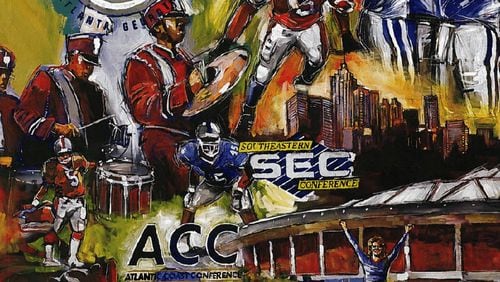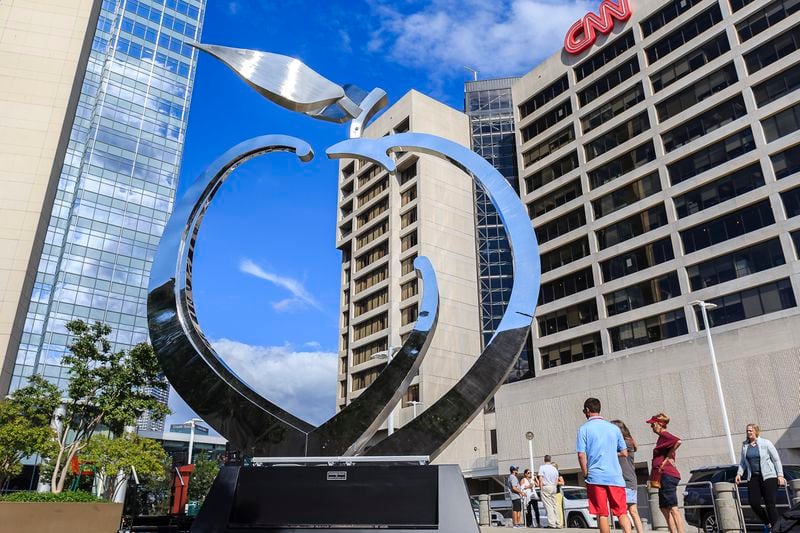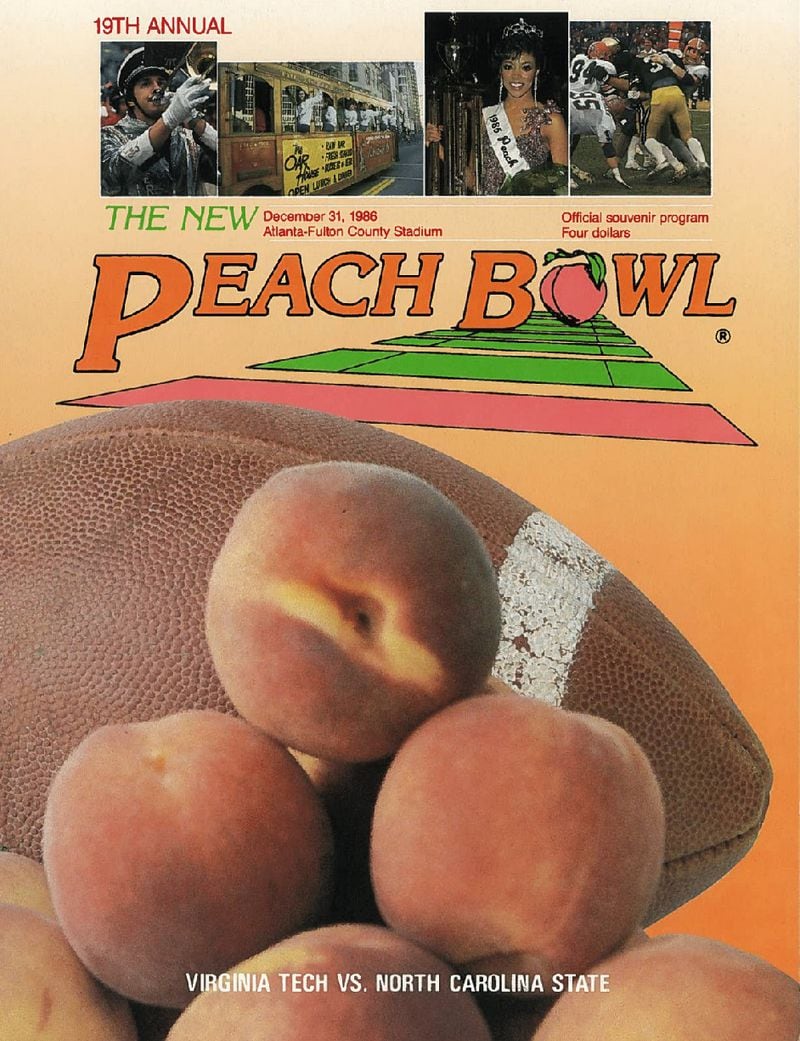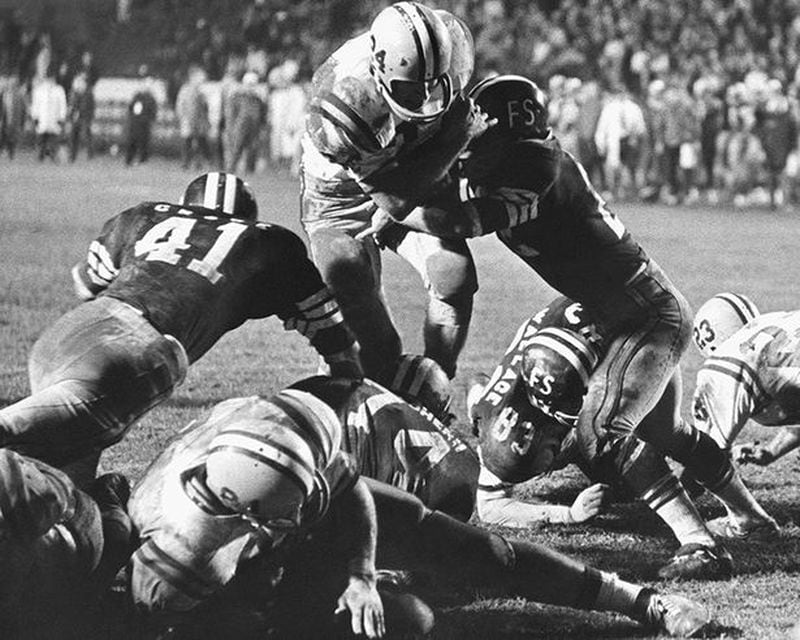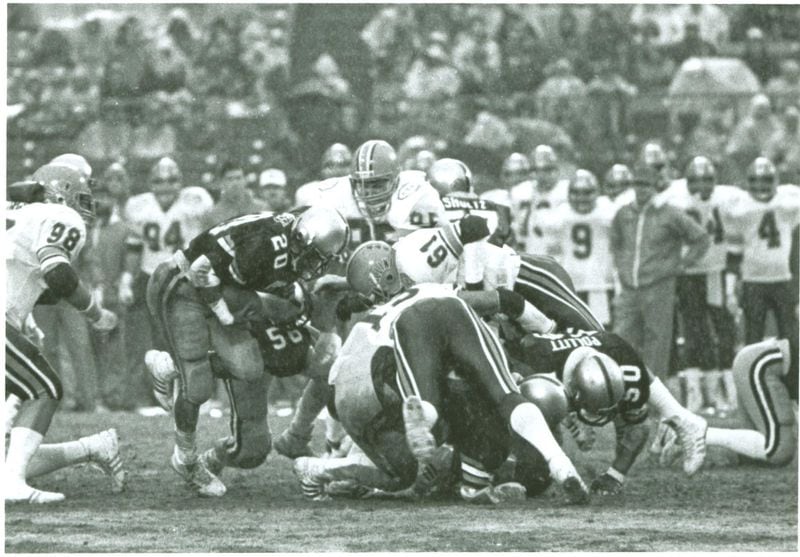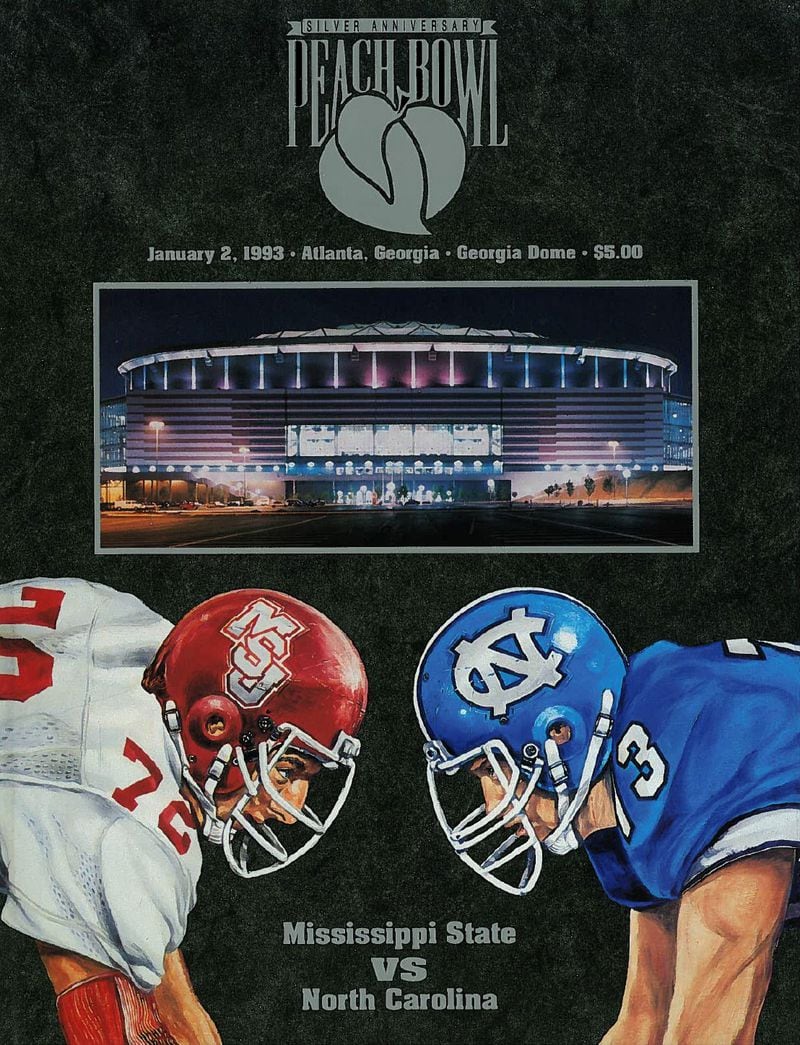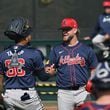Not many college football bowl games can say they have had a 50-year run.
One of those bowls about to cross the half-century threshold and join elite company is the Chick-fil-A Peach Bowl.
No. 7 Auburn, the SEC runner-up, and No. 12 Central Florida, the AAC champion, are set to play in Atlanta’s new Mercedes-Benz Stadium on Monday. This marks the 50th-game in the bowl’s history. The Tigers and Knights will contest in the country’s ninth oldest bowl game in front of a sellout crowd for the 12:30 p.m. start time.
While the celebration will culminate in a high-profile showdown, the Chick-fil-A Peach Bowl has spent much of its milestone year, getting back to its roots. The bowl donated a 30-foot steel peach sculpture to the city of Atlanta. The bowl also gave money to the Atlanta Public School system, and since the beginning of the college football season, the bowl raised over $280,000 to benefit Children’s Healthcare of Atlanta.
Philanthropy was a stated principle for which the Chick-fil-A Peach Bowl was created. Since 1968, it has helped others. The bowl game has faced many challenges and changes. But the founding idea has come full circle, as exemplified by the bowl’s charitable donations this year.
At points in its history, it was a tumultuous task to keep the bowl game alive. However, many key individuals went above and beyond to help it become what it is today – one of the top six bowls in the country and a charitable leader in the bowl community.
Credit: Paul Abell
Credit: Paul Abell
While many people wrote chapters in the Chick-fil-A Peach Bowl’s history, one man started the story; George P. Crumbley, now known as the Father of the Peach Bowl.
The Idea
Crumbley was a member of the Atlanta Lions Club, a branch of Lions Club International, which is a civic organization dedicated to promoting good citizenship across the world. The Atlanta Lions Club was primarily made up of downtown businessmen, according to Albert Tarica. Tarica was also a member of the Atlanta Lions Club and had a major role in the Peach Bowl since its beginning.
In the early 1960’s, Crumbley, who owned the advertising agency Crumbley & Associates, brought Tarica into the Atlanta Lions Club because Tarica was a public accountant for Crumbley’s business. So Tarica got a chance to witness Crumbley’s ambitions manifest from a very close setting.
“He was a very unique individual,” Tarica said. “He was an extremely driven person and I felt that once he got on to something that he was going to make sure it worked.”
Crumbley wanted a way to raise money for the blind, which was the Lions Club’s main charitable endeavor. In 1949 The Atlanta Lions Club formed The Lions Lighthouse for the Blind, which was a non-profit providing vision and hearing services to uninsured and under-served residents across Georgia.
Knowing how prevalent college football was in the South during that time, Crumbley settled on an end-of-season bowl game to generate money to donate to the Lighthouse. His hope was that all the proceeds from the game would be donated to helping the visually and audibly impaired, making the bowl the first ever charitable bowl game.
“Using college football was perfect,” said Gary Stokan, the current president and CEO of Peach Bowl, Inc. “There weren’t any pro teams down here so you had generation after generation of college football fans filing into small college towns, and was the sport’s protein.”
Before the Atlanta Lions Club could pat themselves on the back for their good deed, Crumbley had to get the NCAA to sign off on his bowl idea. So, he formed a six-man committee of Atlanta Lions to bid for a new Atlanta-based bowl. The group had to show what their intentions were with the game and confirm they had the ability to make the minimum payout to the schools who attended, which was $100,000 at the time.
Crumbley and his group went before the NCAA bowl committee in 1966. Like many pioneers, they were denied certification on the first try. But that didn’t deter Crumbley.
“The best thing you can say about George is that he had a sign in his office that said, ‘If you want something done, give it to a busy person because nobody else has the time,’” Tarica said. “Basically, they will get it done no matter what.”
Crumbley and the group went back a year later to resubmit their proposal. Same result. The NCAA, as Tarica put it, wasn’t sold on the fact that the bowl could make the minimum payouts to the teams if the game was going to be primarily used as a fundraiser for The Lighthouse. Knowing that the six-man committee might have to put up some of their own collateral to ensure the payouts were made, a few members of the committee backed out. But that once again wasn’t enough to stop Crumbley.
In the beginning of 1968, the third and final presentation to the NCAA was a success. Crumbley and the remaining members didn’t give up on the charitable foundation of the bowl, but each agreed to personally guarantee the payout if there either wasn’t enough funds from TV or attendance.
The bowl certification from the NCAA came in the mail in April of 1968, forming the ninth bowl game in college football history. Now all Crumbley had to do in the next eight months was put together a bowl game.
The Preparation
Arguably the most important decision in the bowl’s history came next. What would Crumbley call his newly created bowl game? The answer was obvious. In college football, there was already the Rose Bowl in Pasadena, the Orange Bowl in Miami, the Sugar Bowl in New Orleans, the Cotton Bowl in Dallas – all items which are known for those particular regions. Crumbley tossed out one name: The Peach Bowl.
“We are the Peach State after all,” Tarica said. “It just made sense.”
With the name in place, more important matters could be attended to, like finding two teams, securing a field to play on and promoting something that was the first of its kind in Atlanta.
Back before the College Football Playoff and the Bowl Championship Subdivision, Stokan described the process for fielding teams for bowl games as the “wild, wild west.”
“You just contacted any team you could that was having a good season and try to talk them into playing in your bowl game,” Stokan said. “And then another bowl would try to talk to them. It would become a bidding war. You could talk to any team, anywhere to work out a deal and try to find the best matchup possible.”
Tarica said he didn’t know for sure, but suspected that Crumbley contacted just two teams to play in the inaugural Peach Bowl. And luckily both Florida State, who finished 1968 at 8-2 and Louisiana State, who finished at 7-3, agreed to be a part of the bowl’s history.
“They were the up-and-coming teams in college football so everyone thought it would be a good matchup,” Tarica said.
While the teams weren’t selected until the 1968 season concluded, the field search and promotion of the game happened before Crumbley even had the NCAA’s blessing. Tarica said the third time Crumbley and his committee of Atlanta Lions went before the NCAA he had a feeling he was going to get the bid approved.
Crumbley and Georgia Tech agreed on a rental fee so the Peach Bowl could be played at Grant Field. He also agreed to a television contract with Mizlou Television Network -- which is no longer in business – to air the game. Mizlou struck a deal to delay the broadcast of the game on WSB-TV.
“Georgia Tech and WSB were such good friends to the bowl when it started that it probably wouldn’t have had the initial success without them,” Tarica said. “The hardest part in the short period of time was selling the tickets to something that had never been there before.”
With the help of WSB, the new bowl received a fair amount of promotional air-time leading up to the game.
As for the man-power needed to make sure everything ran smoothly on game day, Crumbley turned to fellow members of the Atlanta Lions Club for help. Apart from Crumbley and two other employees who made up Peach Bowl, Inc., everyone else were volunteers.
Tarica didn’t begin volunteering with the Peach Bowl until its second year of existence, but because of his association with the Atlanta Lions Club, was aware of the dedication and diligence exemplified by those helping put on the first bowl.
“Those volunteers were the life blood of the Peach Bowl,” Tarica said. “There were eight volunteers and they had to do the parade, the game, they had a dinner, they had luncheons, a pep rally, literally everything.”
By comparison, Peach Bowl, Inc., now has 14 full-time employees and hundreds of volunteers.
“God bless them,” Stokan said. “There were just eight guys who weren’t full-time staff and they practically started the game. I can only imagine them trying to put something like this on.”
Tarica said the closer the game got, the more everyone (especially Crumbley) realized how lucky they were that everything came together. In just eight months, the Peach Bowl found its home at Georgia Tech’s Grant Field, had its broadcast partner in Mizlou Sports Network, rallied volunteers to put the game on, were being promoted on WSB-TV and had locked in two good teams.
The only thing they needed now was for Dec. 31, 1968, to be a memorable day in Atlanta.
The Game
When Tarica thinks about the game, which he attended as a spectator, one thing always seems to stand out in his mind: the weather. It was a crisp 39-degree day in Atlanta. The skies above Grant Field dumped water onto the fans and teams. But that didn’t stop Tarica or a reported attendance of 35,545 from enjoying the first ever meeting between LSU and Florida State.
“The atmosphere was good,” Tarica said. “Everyone there seemed to have a good time.”
The inaugural Peach Bowl was supposed to showcase two contrasting offensive styles – Florida State’s potent aerial raid and LSU’s ground-and-pound attack – however that script was completely forgotten early in the game as the contest turned into a see-saw battle and became one of the most exciting bowl games of the 1968 season.
LSU turned the football over four times on their first four possessions, which led to a Tom Bailey 36-yard rushing touchdown and a 21-yard touchdown reception from Bill Cappleman to Bill Gunter, giving Florida State a 13-0 lead early in the second quarter.
The Tigers broke through midway through the second quarter when Craig Burns returned a punt 39 yards for a touchdown to cut the lead to 13-7. Then, kicker Mark Lumpkin booted a 22-yard field goal just before halftime to cut the Tiger deficit to 13-10.
“It was a good game, but that weather was something else,” Tarica said. “If you were there for the teams, you stuck around and thought it was great. If you were there just as a spectator, then you probably left a little early. ... I hate to admit it but I left a little after the half.”
Tarica’s decision to leave meant he would wind up missing an entertaining second half.
LSU’s offense found its rhythm on the opening possession of the third quarter. Led by quarterback Mike Hillman, the Tigers drove 51 yards in eight plays to score the go-ahead touchdown, which came on an 11-yard pass from Hillman to wide receiver Bob Hamlett. On their next possession, Hillman found Bill Stober for another 11-yard touchdown pass to increase the Tigers lead to 24-13. But the Seminoles wouldn’t go away.
Florida State opened the fourth quarter with a 72-yard drive capped by a two-yard Ron Sellers touchdown reception from Cappleman. The score remained at 24-19 after the Seminoles failed to convert the ensuing 2-point conversion. But the Seminoles offense was back in business moments later when the Tigers’ kick returner fumbled the kickoff. Sellers hauled in his second touchdown catch of the game and this time the Seminoles successfully converted the 2-point conversion to retake the lead 27-24.
Despite the adverse weather conditions, LSU began to march back down the field as the clock crept toward all zeros. Facing a third-and-19 inside Seminoles’ territory, Hillman dropped back to pass and found wide receiver Tommy Morel for a 20-yard reception to put the Tigers in scoring range. Running back Maurice LeBlanc then punched in a 2-yard run to cap a nine-play, 61-yard drive and put LSU back in front 31-27.
The game wasn’t over. The Seminoles quickly moved deep into Tigers territory, but their drive stalled inside the 10-yard line. First down, second down, third down, but still no touchdown for Florida State. The game came down to a fourth-and-goal. Cappleman took the snap and dropped back to pass, he looked in the direction of Sellers and threw him a jump ball. The two-time All American went up to make the game-winning catch, but at the last moment the ball was knocked out of his hands by LSU’s Barton Frye.
The Tigers took over on downs and ran out the clock for the victory in the first-ever Peach Bowl.
“The fact that it was such a close game and a good matchup with two good teams, it really gave us a good jump start and I think it was very fortunate that we got those two teams,” Tarica said.
More importantly, the idea behind the game was preserved. With the success of the game, Crumbley and the Peach Bowl donated $100,000 to the Lions Lighthouse, made the $100,000 payouts to LSU and Florida State, and put money in their reserves to bid on future teams for their bowl games.
The Peach Bowl would donate $100,000 to the Lions Lighthouse after every bowl game until the mid-1980s.
The evolution
Since that first game, the Peach Bowl has gone through many changes.
Three years after the LSU-FSU game, the bowl moved from Grant Field to Atlanta-Fulton County Stadium, however weather still seemed to hinder the success of the bowl.
“I liked to make the joke that before Chick-fil-A was our title sponsor, our sponsor was ‘weather-plagued’ because every article started ‘the weather-plagued Peach Bowl’” Stokan said. “I remember the first game I volunteered at in 1985 we were hanging signage over the Braves’ retired jersey numbers in Fulton County Stadium. I was trying to hang a sign over Phil Niekro’s number 35 and I literally couldn’t feel my hands.”
Years and years of bitterly cold and rainy weather since the stadium transition, including the 1985 game which Stokan said Army and Illinois played in a “foot of mud,” didn’t help with putting local fans in seats. Attendance stayed stagnant for years and the bowl stopped making money. With more and more bowls being added to college football, bidding for teams to attend the Peach Bowl became more expensive, and the Peach Bowl struggled in its mission to donate $100,000 to the Lions Lighthouse. And on top of all that, Crumbley had a heart attack in 1985 and had to step down from his executive director position. Stokan said many feared the bowl was going to be disbanded.
However, the next couple of years proved to be the most vital in not only keeping the bowl alive, but helping it thrive and become a member of the New Year’s Six today.
The Peach Bowl brought in former Virginia head coach and Missouri assistant athletic director Dick Bestwick to be the new executive director in 1985. After that year’s Peach Bowl, which only drew 29,000 fans, Bestwick had seen enough. He knew the success of the bowl couldn’t fall solely on the commitment from the Atlanta Lions Club.
So Bestwick went to the Atlanta Chamber of Commerce, which had just formed its Sports Council and told Jerry Bartels, who was the president of the Atlanta Chamber of Commerce, that “if the business leaders don’t step up to buy tickets and work with the Peach Bowl through sponsorship, then the bowl was going to go out of business.
“Bestwick said why don’t you (the Atlanta Chamber of Commerce) take this over as your big project for the Sports Council,” Tarica asked?
And the chamber of commerce went all-in.
“Bartels went to Ron Allen, who was a chairman at Delta Airlines, and told Allen, ‘Hey we don’t want this bowl to go away.” Stokan said. “Delta wrote the first check at $100,000 and Allen went to his chief marketing officer at Delta Bob Cogan and Bob went out to every one of the vendors Delta had and sold 3,300 tickets and those two things really gave us a foundation to start with.”
Delta became the first official sponsor and the Atlanta Chamber of commerce took over the operation of the Peach Bowl in 1986. Unfortunately, this meant in the short-run, the bowl couldn’t donate money to the Lions Lighthouse, but it was a beneficial move in the long run.
Despite the new management increasing its resources devoted to expanding local sponsorship and promotion of the game, playing outdoors in winter was still a problem. That all changed when the Georgia Dome was built. It completely changed the forecast for the “weather-plagued Peach Bowl.”
“We could finally tell teams coming, it’s going to be 72 degrees and clear at kickoff,” Tarica said. “That was one of the big turning points in our history.”
The bowl’s new executive director, Robert Dale Morgan oversaw the financially prosperous transition from outdoors to indoors for the 1993 Peach Bowl.
Prior to that though, Morgan helped negotiate a contract with ESPN in 1991 that would televise the Peach Bowl nationally. He also witnessed the creation of the Bowl Championship Subdivision (BCS), where the Peach Bowl would no longer have to go fishing for teams and would instead negotiate with the conferences. In 1992, the bowl reached agreements with the Atlantic Coast Conference and the Southeastern Conference to form the first permanent bowl matchup between the rival conferences.
“At that point, the bowl became must-see TV,” Stokan said.
Tarica became the chairman of the Peach Bowl in 1995 and oversaw the first and only title sponsor to sign on with the bowl: Chick-fil-A. He described the sponsorship deal as a “match made in heaven.” Both sides weren’t necessarily seeking each other out, but were looking to expand their brands. Chick-fil-A wanted to get more involved with college athletics and the Peach Bowl wanted a title sponsor to bring in more money.
“We weren’t looking for each other, but someone put us in the same room and we thought it would be a good matchup,” Tarica said. “When you start looking at things that are (similar between us), we both started in 1968, we are both Atlanta-based companies, and the synergy was just good.”
The sponsorship began in 1996, but morphed into a partnership. And the Peach Bowl and Chick-fil-A became nationally recognizable brands.
“(Chick-fil-A president) Dan Cathy tells a great story when they were looking to move out west some people told him, ‘I know who you guys are, you guys have the bowl game.’ They had no idea what Chick-fil-A was other than (from) the Peach Bowl,” Stokan said.
Stokan took over as the executive director of the newly-named Chick-fil-A Peach Bowl in 1998. With him at the helm, the bowl continued to reach new heights.
In 2006, the bowl rebranded itself as the Chick-fil-A Bowl. In 2007, the bowl went back to its charitable ways, donating $50,000 a year to the Lions Lighthouse in honor of Crumbley. In 2008, the bowl sought to dominate the open weekend of college football by creating the high-profile, neutral-site game in Atlanta. Thus, the Chick-fil-A Kickoff Game was born. In 2009, the Bowl announced a partnership with the National Football Foundation to bring the College Football Hall of Fame to Atlanta. The new Hall of Fame officially opened in 2014. And in 2013, the bowl – now named the Chick-fil-A Peach Bowl -- became one of the College Football Playoff’s New Year’s Six bowls.
On Monday when Auburn and UCF christen the Chick-fil-A Peach Bowl in Mercedes-Benz Stadium, the bowl will celebrate its 50th-year of existence.
Created on the principles of charity in 1968, Peach Bowl Inc., has donated more money back to its community than any other bowl in the country, because that is what its founder wanted it to be about.
Crumbley, who passed away in 2009, didn’t start the Peach Bowl with profits in mind. His mission was to make a difference in the lives of the less fortunate. He thought the best way to do that was by putting on a bowl game. Thanks to his fellow members of the Lions Club, Crumbley’s dream became a reality. LSU and FSU put on a thrilling show in December of 1968, but the real winner of that contest was the Lions Lighthouse.
And even when bowl game looked like it was in trouble of shutting down in mid-80s, its members never gave up on it. It sought the changes necessary to stay alive, leaving its charitable platform for a time, but always knowing that when it succeeded, it would return to its roots. It took a little while but the Peach Bowl finally did. Since 2002, Peach Bowl, Inc., has distributed $22.1 million in charity and scholarship contributions to organizations, more than any other bowl organization in college football.
“If you said we would be one of the top six bowls in the country when we started, I would have said there is no way,” Tarica said. “It’s still almost like a dream.”
About the Author
